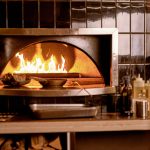You’ve often watched in awe as professional chefs, armed with culinary prowess, navigate their restaurant kitchens with ease. You’ve wondered how they whip up gourmet dishes in no time, and how their workspace is so meticulously organized. The answer to these wonders is the chef’s workstation. These workstations are the beating heart of the restaurant kitchen, designed to maximize efficiency, comfort, and productivity. But can you bring this professional setup into your home kitchen? The answer is yes. This article will guide you on how to integrate a professional chef’s workstation into your residential kitchen.
The Concept of a Chef’s Workstation
A chef’s workstation in a professional kitchen extends beyond just a countertop and stove. It’s a meticulously planned space that ensures efficient navigation, access to items, and workflow. In the bustling environment of restaurant kitchens, a chef’s workstation becomes a personal space where culinary magic happens.
Topic to read : What are the best methods for integrating technology into table service at a high-end restaurant?
To replicate this at home, you don’t need to expand your kitchen or invest in restaurant-grade equipment. Instead, you should focus on the strategic placement of your appliances and tools, enhancing your kitchen’s functionality and layout.
Elements of a Chef’s Workstation
There are specific elements that all chefs’ workstations share, regardless of the size or type of restaurant they work in. Understanding these elements will provide a foundational basis to start creating your workstation at home.
Also to read : What are the best methods for integrating technology into table service at a high-end restaurant?
-
The Cooktop/Oven: This is where the cooking action happens. In a professional kitchen, cooktops are usually powerful and designed for multi-tasking. At home, you might not need a six-burner stove, but you want a reliable cooker that can handle your culinary adventures.
-
Prep Area: This is where the chef does all the chopping, dicing, and food preparation. Ideally, this should be a wide, clean space situated near the cooktop for ease of access.
-
The Sink: A crucial part of a chef’s workstation is the sink, where cleaning and food preparation such as washing vegetables, happens. A double sink can be beneficial for managing dishes while preparing meals.
-
Refrigerator: Finally, easy access to a refrigerator is vital. In a restaurant, multiple low-level refrigerators are often placed around the kitchen. You won’t need this in a residential kitchen, but your fridge should be within a few steps of your workstation.
Planning Your Workstation
Now that you understand the key elements of a chef’s workstation, you need to start planning. This can be a fun yet complex process, as you will need to consider the existing design and layout of your kitchen.
Firstly, think about traffic flow. Your workstation should be in a place where you can work undisturbed, without blocking anyone else’s path. Next, consider the proximity to the sink, refrigerator, and cooktop. Ideally, these should be adjacent to each other in a triangle formation to allow for easy access.
Think about what you need most when cooking and how you can arrange these items for easy access. For example, pots and pans should be close to the cooktop, while your cutting board and knives should be by your prep area.
Integrating Professional Elements
You may not need a restaurant-grade range or a walk-in cooler, but certain professional elements could enhance your home kitchen immensely.
Consider a butcher block countertop, which is more durable and forgiving than most residential countertops when it comes to chopping and slicing. Consider also a pot rack hanging overhead, freeing up cabinet space and keeping your most-used pots and pans within reach.
Lastly, look at restaurant kitchens for organization inspiration. Chefs use everything from magnetic strips for knives to shelving units on wheels for storing ingredients. Find a system that works for you and brings a bit of that chef’s kitchen efficiency home.
Adapting the Design to Your Needs
Remember that the end goal here is to create a space where you feel comfortable and efficient while cooking. So, ultimately, your chef’s workstation should be adapted to your needs and cooking habits.
Are you tall and find bending down to low cupboards uncomfortable? Consider higher countertops. Do you bake a lot? You might want to invest in a standalone mixer and a baking station. Think about what you love to cook and adapt your workstation to facilitate this.
In conclusion, creating your own chef’s workstation at home requires careful planning, but it’s a surefire way to boost your efficiency in the kitchen. Prioritize your comfort and needs, and you’ll be cooking up a storm in your professionally inspired kitchen in no time.
Why Stainless Steel is the Go-To Material in Professional Kitchens
Stainless steel is a regular fixture in professional kitchens, but why is it so widely adopted in these spaces? First and foremost, stainless steel is non-porous, which means it does not absorb or retain any bacteria, making it a hygienic choice for food preparation. This is a crucial factor in restaurant kitchens where food safety is paramount, and cross-contamination needs to be avoided at all costs.
Stainless steel also boasts a high resistance to heat, rust, and corrosion. This makes it extra durable, essential for the rigorous, high-pace atmosphere of a commercial kitchen. In addition, this material is easy to clean and maintain; it can be swiftly wiped down, removing any food particles and grime.
If you’re serious about creating a chef’s workstation at home, consider integrating stainless steel into your space. You could opt for a stainless steel countertop next to your cooktop, acting as your prep station. Or, a stainless steel sink could be an excellent addition, particularly a single bowl kitchen sink, which offers plenty of space for cleaning and food preparation.
The Importance of a Mise en Place Layout
Mise en place is a French term used in the culinary arts, translating to ‘everything in its place.’ This principle is critical in professional kitchens, where efficiency and speed are vital. Chefs meticulously arrange their tools and ingredients before starting to cook, allowing them to stay focused and maintain a smooth workflow.
In your home kitchen, adopting a mise en place mindset can greatly improve your cooking experience. To start, invest in a cutting board that will serve as your central prep station. This is where all your chopping, dicing, and slicing will occur, so ensure it’s large enough for your needs and within easy reach of your cooktop.
Next, consider your storage. Are your utensils and ingredients easily accessible? A popular solution in professional kitchens is using open shelving or a pegboard for hanging utensils. This way, everything is visible and reachable. For ingredients, consider clear glass jars or airtight containers that allow you to see what’s inside easily.
Lastly, remember the golden rule of mise en place: clean as you go. This prevents cross-contamination and keeps your workspace tidy, reducing stress and making the cooking process more enjoyable.
Conclusion
Incorporating a professional chef’s kitchen design into a residential kitchen is an exciting project that can transform your meal cooking experience. Remember, it’s not about replicating a restaurant kitchen verbatim. It’s about adapting professional kitchen principles to your home – enhancing the kitchen layout, prioritizing food safety, and increasing efficiency.
Stainless steel makes an excellent addition to any chef’s kitchen, thanks to its durability, ease of cleaning, and food safety qualities. Meanwhile, adopting a mise en place approach to your kitchen organization can streamline your workflow and make meal preparation smoother.
Finally, always adapt the design to your specific needs and habits. Whether you’re a budding culinary school graduate or a home cook who loves experimenting, a chef’s workstation will undoubtedly elevate your culinary adventures. So why not take the plunge, utilize these insights, and start enjoying the benefits of a professional kitchen in your home?











